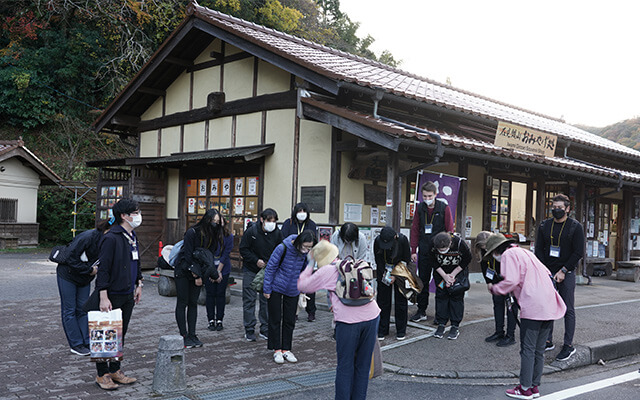Kumagai Residence (Important Cultural Property)

First, we visited the Kumagai Residence. This is a residence once owned by a wealthy merchant and a large-scale private house that was built in the Edo Period [between the 17th and mid-19th centuries] with a main building, five warehouses and a storehouse in a vast land of approximately 1,500 m². It was designated as an Important Cultural Property by the Japanese Government in 1998 and has been open to the public since 2006.
The Kumagai Family was the wealthiest merchant family in the Iwami Ginzan, an area directly controlled by the Edo shogunate, and reportedly ran the family business including mining, brewing and financial businesses, as well as serving as a purveyor of a local governor’s administrative office. This enormous house has a staggering 30 rooms, which demonstrates the Kumagai Family’s great power at that time. There is a lot to see such as a basement warehouse where some people were said to have secretly put a ladder to go in and out of there.
This facility offers not only a visit to the inside of the residential building, but also hands-on experience to cook rice with kamado, Japanese traditional stoves, in the kitchen of the residential building. The group of multinational CIRs headed to the kamado cooking experience right away.
“What a tough life for the wives it was in the Edo Period…”
Having been guided to the residence’s kitchen, lots of traditional solid kamado stoves sit side by side. For how many dozens of people did they used to prepare with these kamado stoves at that time, approximately 200 years ago?
“Your clothes will get stained with soot from the stoves, so please wear these aprons and bandanas,”
said female staff members who gave the participants handmade aprons embroidered stitch by stitch with care by the staff.
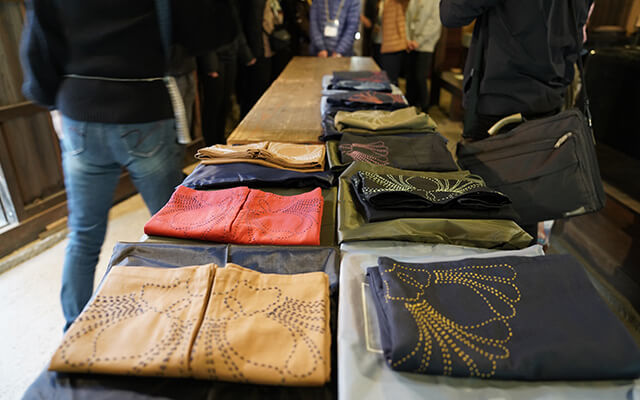
Each participant wore one each of these and covered their head with a bandana to be ready.

The method that women in the Edo Period reportedly used to cook rice in their everyday life is accurately performed in the kamado cooking experience: first, measuring rice with a masu, Japanese measuring cup, then washing rice.
“The tip for rice washing is to wash it gently at any rate. If you rub the rice by force, the rice get stressed and won’t be cooked tastily.”
“For measuring water, unlike present days, there was no rice cooking pot with scale lines at that time, they used to measure using a certain height of their arms as a guideline.”
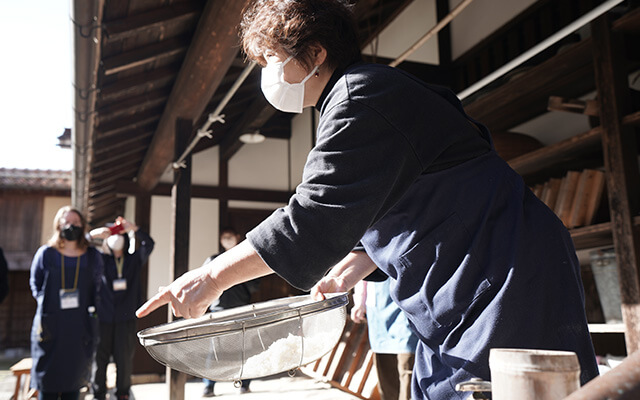
The participants were eagerly listening to such wisdom for life of people passed down from olden times to cook such tasty rice.
While waiting for the rice to absorb water, the participants experienced wood chopping. In the Edo Period, people needed to make a fire every time they cooked, and securing fuel used to be one of the most important tasks.
First, hold a billhook in your dominant hand and support a piece of wood with your other hand. Then, put the edge of the billhook, aiming the center of the wood. Keeping that position, move the hand with the wood up and down to hit the table, and the wood will split into two along its grain.
tried wood chopping, taking turns.

It made them feel good when the wood was nicely split into two, and they couldn’t help but smile.
Next, they lit the fire, putting the firewood that had just been cut. No sooner than did a female staff member light the fire to the firewood than did white smoke rise and fill the spacious kitchen. The smoke stung their eyes.
Without delay, she fanned with a hand fan in her hand and checked the fire. If the fire is slightly weak, you need to blow it with a bellow called fuigo. On the contrary, if the fire is strong, spread out the firewood to reduce it. At any rate, you need to stay at the kamado stove to keep on watching how strong the fire is until the rice is cooked.

The smoke stung their eyes and hurt their throats if it was inhaled. It was harder work than they imagined.
“What a tough life for the wives it was in the Edo Period to cook rice every day,”
one of the female CIRs thought out loud.

An exciting sweet potato digging competition
It was going to take approximately between 30 to 40 minutes until the rice was cooked. In the meantime, the participants experienced sweet potato digging in a field of the premises while taking turns to look after the fire with a fan.
“Let’s have a competition to see who will dig up the largest sweet potato!”
The sweet potato digging competition suddenly began with a shout by a female staff member. The participants with aprons began digging sweet potatoes in the field all at once.
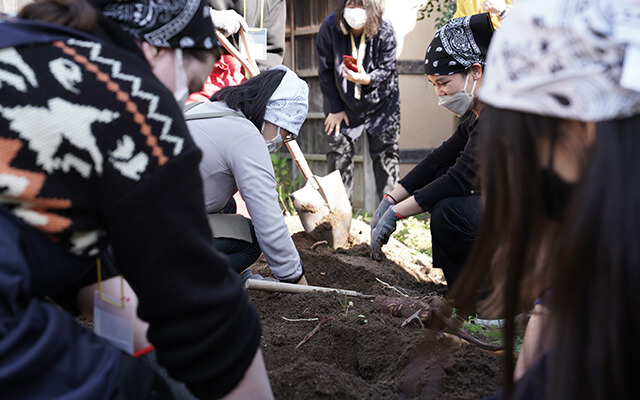
“It’s like a treasure hunting!”
“Look! I have dug a twin sweet potato!”
“I must be a genius sweet potato digger!”
There were shouts of joy here and there, and it became the liveliest event of the day.
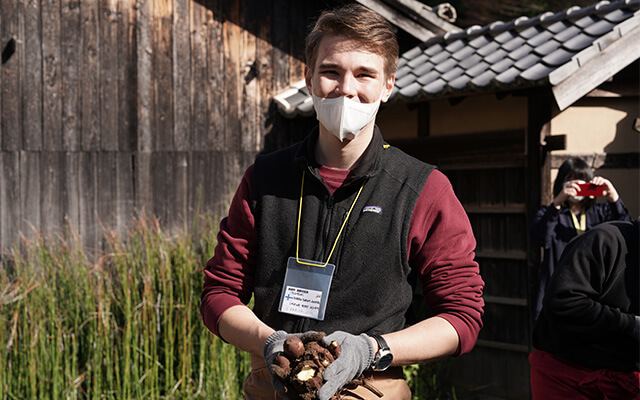
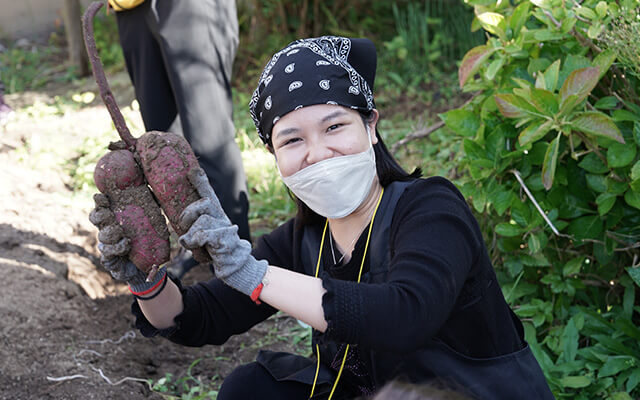
“The rice water from washing rice and ashes from kamado stoves are used as fertilizers in this field. Like this, people in the olden days wisely didn’t produce any waste while cooking rice.”
“To store dug sweet potatoes, they should be wrapped by newspaper without removing soil and left next to a fridge. Because the side of the fridge is slightly warmer even in winter, the warmth helps sweet potatoes last longer.”
Female guides of the Kumagai Residence imparted their wisdom of life passed down from the olden days in between activities.
After that, wild herbal tea made with wild herbs grown in the garden was offered.
The wild herbal tea is a blend of five types of wild herbs with especially good fragrance such as mulberry leaves and sickle pod weed among those grown in the garden.
The tea was poured into the water bottles that each participant had brought with them to enjoy with rice balls that they were later going to make with the rice cooked in the kamado stove.
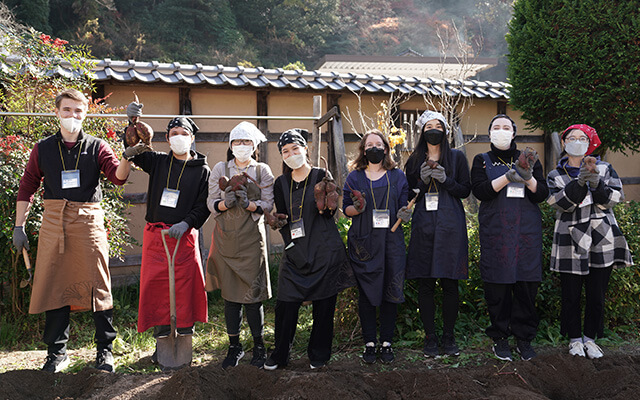
Let’s see the cooked glossy rice!
In the meantime, the rice seemed to have been cooked. Having turned off the fire and left the rice with the lid to steam slowly, they then opened the lid…
“Ooh!”
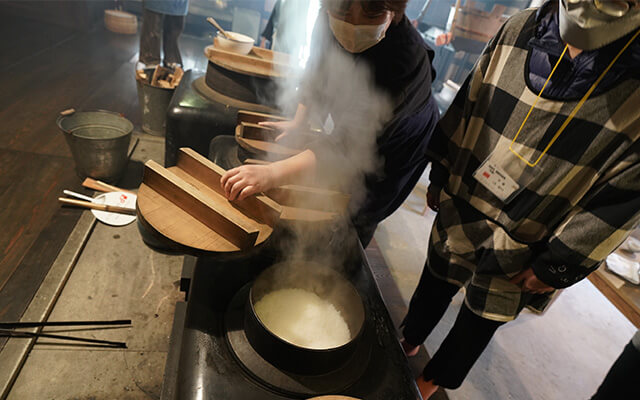
Glossy, shiny rice appeared with an enormous amount of vapor spreading upwards.
An outburst of exclamations from the participants spontaneously arose.
“We’ll cast the spell to make the rice even tastier. In the meantime, we will take you to visit the residential building.”
What spell will they cast to make this freshly cooked rice even tastier?
Exploring the inside of the residence
While the staff was preparing to make rice balls with the cooked rice, the participants split into two groups to explore inside of the residential building.
An elegant entrance that is the same style of that of a samurai residence, the casher’s counter where silver was reportedly weighed with a balance scale, and transoms like beautiful shadow pictures decorating the upper part of the drawing room show how powerful and wealthy the Kumagai Family used to be in this area in the Edo Period.

You can find the display models which reproduce as detailed as possible: tableware, clothing including kimono and trousseau at that time in each room.
This mini tour, going up and down the steep stair cases and looking around over 30 large and small rooms, was like an expedition yet very interesting. The participants were eagerly listening to the guide.
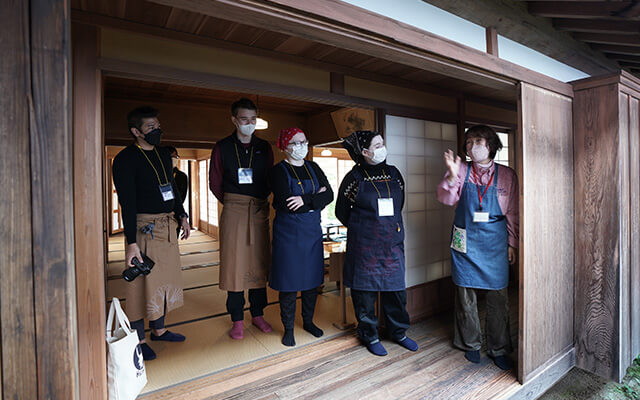
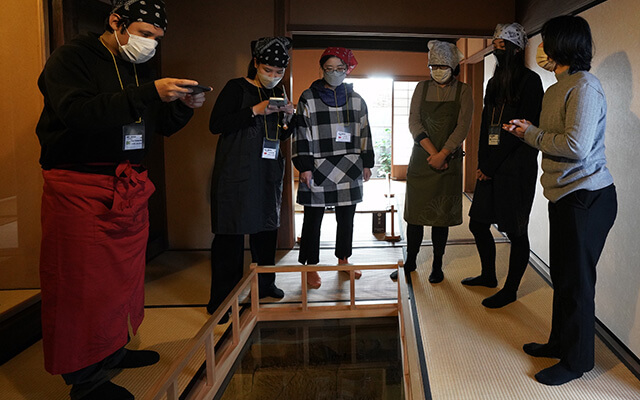
Experiencing making a rice ball
Having come back to the kitchen from the exploration of the luxury residence, a preparation for making rice balls was ready.
Ingredients were nicely placed on a tray for each person. Some items to decorate a rice ball were also prepared.
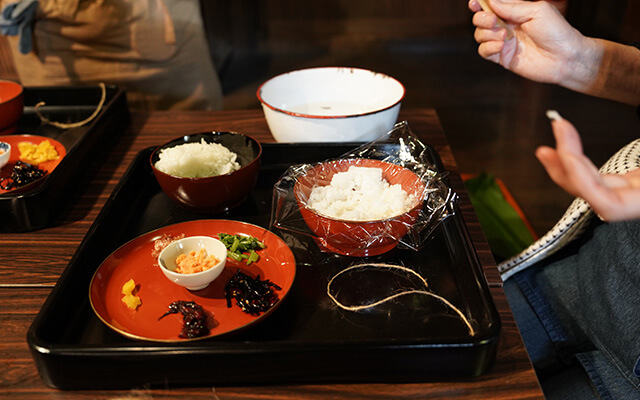
The participants were surprised, as they took it for granted that they were going to make a usual rice ball by shaping rice with hands, yet they couldn’t help show excitement, wondering what was going on.
Six ingredients were ready for a rice ball: bonito flakes, salmon flakes, pickled turnip greens, seasoned kelp with perilla flavor, pickled radish and Japanese apricot (ume) jam. Those fillings were carefully selected for the participants to enjoy various flavors in a rice ball.

Following the guidance of the female staff members, the participants put the fillings of their choice and shaped their rice balls.
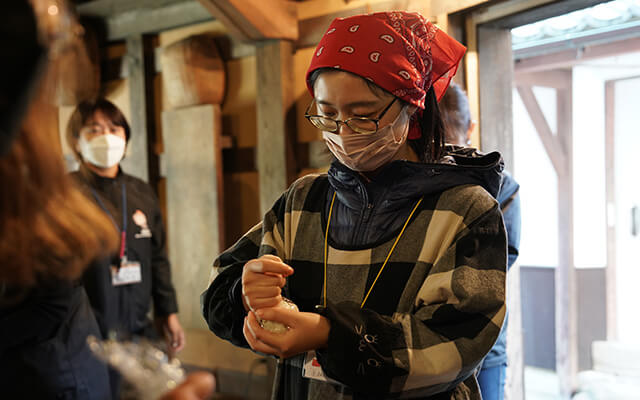
“Wow! Well done.”
“Looks good!”
With the flattery of the staff, their one and only rice balls were about to be ready.
A large-size triangle rice ball needed a little decoration for a finishing touch: wrapping it with a cast-iron plant leave, tying with a hemp string and decorating with ivy leaves and nandina berries on the knot. Voila!

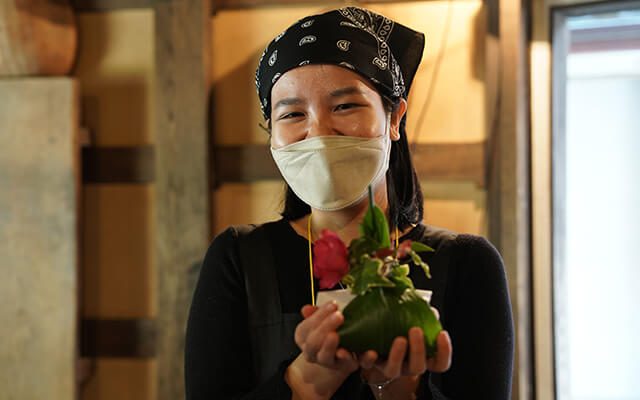
Their very special rice balls looked completed, but a further enhancement was awaiting.
They wrapped the decorated rice ball with a cloth like a scarf and attached the leather handle to it…
It turned into a very pretty “rice ball bag”!
What a great idea it was! It made the participants have a big smile.
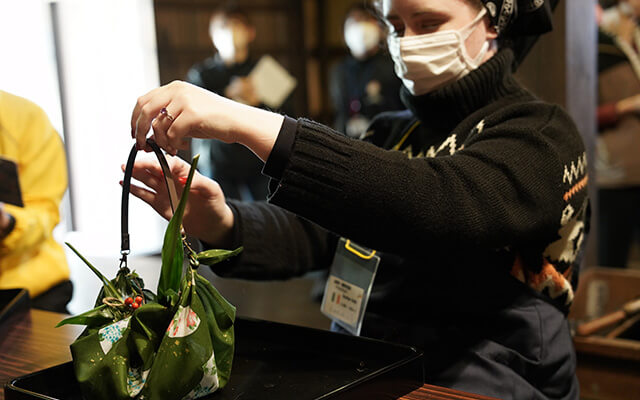
“We came up with the idea, considering that the participants could enjoy it as if they were picnicking with their rice balls which were full of their efforts.”
It was excellent and detailed hospitality with great consideration by the female staff members.
It showed their heart-warming thought for the participants to be able to thoroughly enjoy the activity.
At last, everyone took their own homemade rice ball in the bag and water bottle with wild herbal tea to the garden for lunch.
“Let’s eat!”
They followed each process step by step with their time and efforts, and shaped their rice ball with their hands. Its taste must have been exceptional.
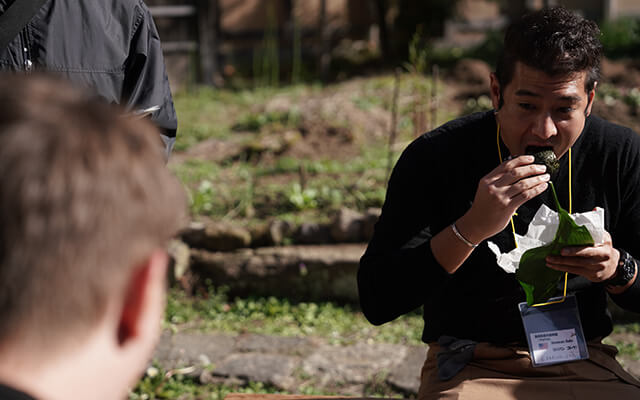
“It’s really tasty!”
one of the participants said with a big smile.
In the late-autumn garden where the warm sunlight was pouring down, the chatting voices of the CIRs from various countries were echoing.
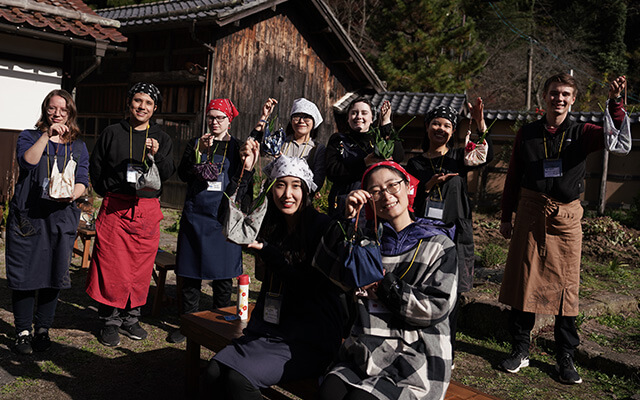
The Iwami Ginzan Silver Mine, Ryugenji Mabu Mineshaft Guided Tour
Being full up with the superb rice balls, the participants headed to the Ryugenji Mabu Mineshaft Guided Tour—the highlight of the Iwami Ginzan Silver Mine—a World Heritage Site.
The tour is also called a “one-coin guide” as you pay literally just one 500-yen coin for a guided tour. The tour includes a leisurely 90-minute one-way stroll through Omori Town to the mineshaft with a wonderful guide.
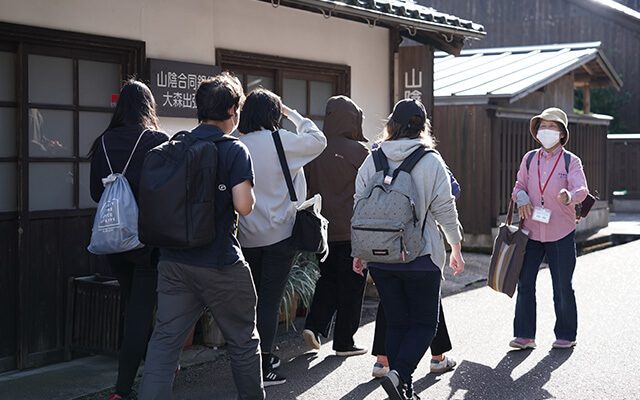
Its tour guides are local volunteers. Every guide has deep knowledge of the history of the Iwami Ginzan Silver Mine and information on Omori Town, and their clear-cut yet detailed explanations are very popular.
Brilliant tour guides with abundance of knowledge to hold participants’ attention from the beginning to the end
On that day, they were divided into two groups, and each group had a guide. The groups departed the Kumagai Residence through Omori Town to the mineshaft on foot.
“Look, there is no electric cable in Omori Town, is there? The cables were buried under the roads on purpose to preserve its traditional townscape,” said the guide.
Actually no electric cables could be seen above this town.
“Also, modern machine-like objects such as outdoor units of the air conditioners and vending machines are all covered by wooden materials. Every resident in the town spontaneously does it to preserve the townscape that has been maintained from the olden days.”
The residents’ steady spontaneous efforts to protect this historical town could be seen here and there.
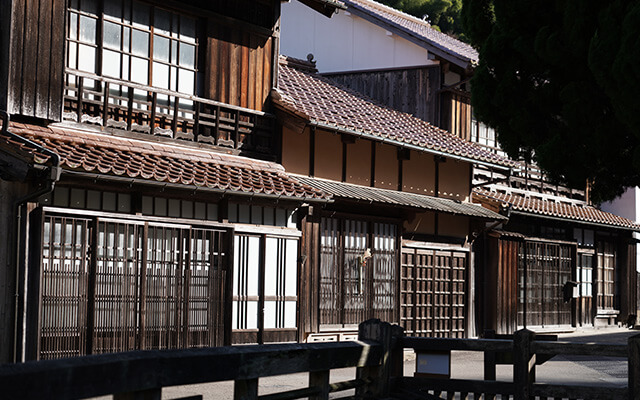
The guide astounded us by continuously explaining every time the group passed the places of interest on the way to the mineshaft.
As an experienced guide, her explanations from various perspectives were backed by a great deal of knowledge: a story about a nursery school in Omori Town where the whole community cooperated with child-rearing;
limiting car traffic into the town to protect the valuable ecosystem in the town with a World Heritage Site from car exhaust;
a silver refining method that used to be employed when the silver mine was prosperous; and traditions of the town which is said to be on top of the silver mine.
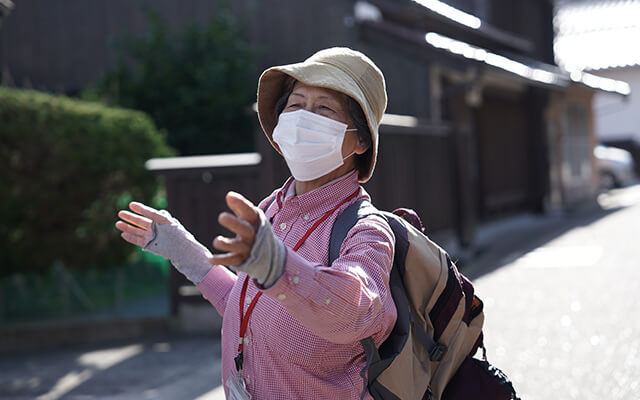
Without such a knowledgeable guide, it would have been just a quick uninteresting visit by rented bicycle.
Walking with detailed explanations helped us to imagine the prosperous atmosphere of the silver mine town which certainly existed 500 years ago: the miners who were devoted to mining silver even if their lives were in danger; and people who carried heavy silver on the back of horses to the Setouchi Region, taking days and days.
It enabled us to feel that the tour was realistic. That is why it is said that how satisfied you will be with your visit to the Iwami Ginzan Silver Mine depends on whether you have a guide or not.
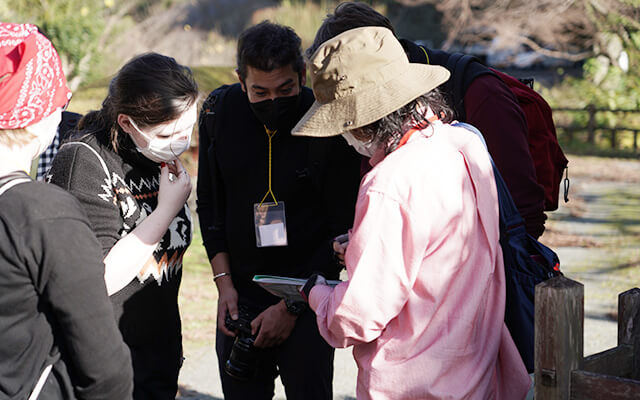
The participants enjoyed a stroll to the silver mine, listening to the guide’s cheerful talk attentively all the time.
The Ryugenji Mabu Mineshaft—the largest mineshaft in the Iwami Ginzan Silver Mine
More than 900 small- and large-sized mineshaft tunnels were discovered in the Iwami Ginzan Silver Mine. Among them the most representative mineshaft tunnels of all is this Ryugenji Mabu Mineshaft.
The total length is approximately 600 meters, and approximately 160 meters from its entrance is open to the public so that the visitors can actually walk there.

Stepping into the dark narrow tunnel, the traces of digging by chisels can clearly be seen on the rock surface.The rocks were dug up absolutely only by hand by miners to find veins of silver at that time.
If you look inside of the tunnels splitting left and right, you will see those tunnels branching off numerously like an ants nest. In this way, the parts where adits were also dug means that there use to be veins of silver. You can see the passion of the miners at that time, who tenaciously kept on crushing rocks to dig as much silver as possible.
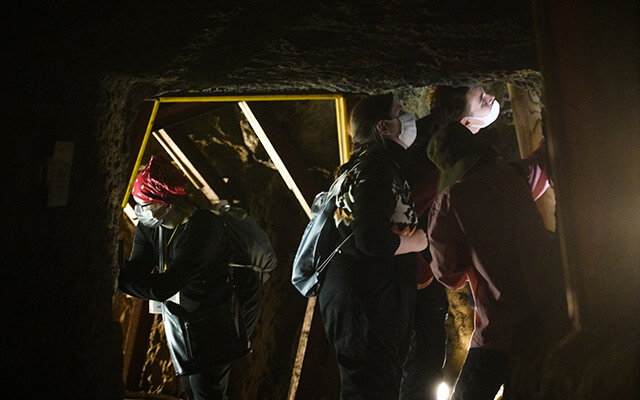
Nowadays, some lights are fitted for displays, at that time they reportedly used to dig the rocks in a pitch black tunnel, relying on only a little fire lit by vegetable oil in a turban shell called rato. Therefore, you can still see numerous little hollows on the rocks, on which rato, turban shell lights, probably used be placed.
“The condition of the silver mining site was harsh; the oxygen was low in the dark narrow tunnels, and the rocks could collapse any time. Working there meant having a brush with death, so if a miner reached 30 years old, he had a celebration for longevity.”
Thinking about the workers then who kept on digging the mine, risking their lives, we carried on going further down, then reached a bright wide new tunnel leading to the exit.

It felt somewhat relieving.
Thanks to the guide, the tour was many times more fun
On the way back from the mineshaft, I asked one of the participants, a CIR who came to the prefecture from Vietnam, how the guided tour was.
“In the mineshaft tunnel which we saw at the end, I was amazed by the fact that people had dug such holes only by hand when there had been no machines available.”
“Actually, I have once visited the Ryugenji Mabu Mineshaft without a guide, then I had no idea where to go and got lost. I ended up not knowing how to enjoy it there, but this time I made the most of it and enjoyed it thoroughly, thanks to the guide.
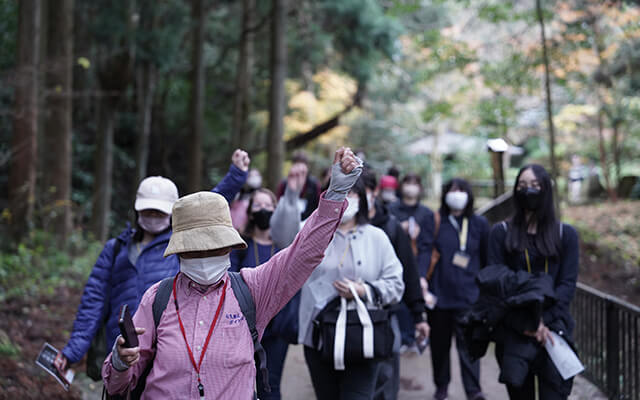
Moreover, what surprised us was the female guide who almost definitely was the eldest of all tour participants was the most energetic of all. She talked energetically about how attractive and interesting Omori Town and the silver mine were without looking tired at all.
“Well everyone, see you again!” at the end, she said and waved to us with a cheerful smile, and the tour ended.
